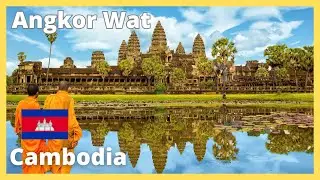Cambodia's BEST Kept Secret Angkor Wat in 4K
In this video, we will explore the stunning complex of Angkor, the jewel of Cambodia! Let's delve into the rich history of this UNESCO World Heritage Site and discover the secrets hidden in every corner of this magnificent temple.
This tour took place on March 29, 2024.
--------------- Video chapters:
0:00 Summary
0:25 Ta Prohm
1:47 Angkor Wat
3:26 Angkor Thom
3:59 Bayon Temple
5:27 Baphuon Temple
6:32 Elephant Terrace
-------------- Places visited on this tour:
The entire Angkor complex was declared a World Heritage Site by UNESCO in 1992.
ANGKOR WAT
The temple is famous for its grand architecture, with lotus-shaped towers rising 65 meters high. The complex covers an area of 162 hectares, filled with intricate corridors, spacious courtyards and walls adorned with reliefs depicting scenes from Hindu mythology.
Built at the beginning of the 12th century, it is undoubtedly the best-known, most beautiful and best-preserved temple in the entire complex.
This temple is the largest religious building ever built in the world and a source of great pride in Cambodia, to the point of being at the center of the national flag.
With the fall of the Khmer Empire, Angkor was abandoned, which led to the temples being taken over by the jungle in the following centuries.
The only exception was Angkor Wat, which continued to be inhabited by Buddhist monks. Perhaps that is precisely why the building has remained so well preserved.
Angkor Wat, initially built as a Hindu temple dedicated to the god Vishnu and later converted into a Buddhist temple, is a living temple even after the city was abandoned. Even today the odor of the incense burned by the veneration of the Buddha images, which are somewhat damaged, spreads through the air and prayers are said with respect and humility.
In 1586, the Portuguese Capuchin friar António da Madalena and the Portuguese historian Diogo do Couto visited the temple and wrote:
"...a construction so extraordinary that it is not possible to describe it in writing, especially it is unlike any other building in the world. It has towers, decoration and every refinement that human genius can devise."
TA PROHM, TEMPLE OF THE ANCESTORS
Anyone who has seen the film Tomb Raider will certainly remember images of this temple. The film made famous the monastery of Ta Prohm (Temple of the Ancestors), another of the ex-libris of the Angkor Wat archaeological park. Here we can see and feel what the “discoverers” of Angkor experienced when they arrived here. Once abandoned, the megacity of Angkor was patiently reclaimed by the jungle over the centuries that followed. A magical place where trees grow majestically from any corridor or wall.
The restorers decided to keep Ta Prohm as it was “discovered”, unlike other temples that were cleaned and rebuilt during the last century, as this is the only one that blended perfectly with the jungle. And today, we can no longer distinguish whether these deep-rooted giants destroyed this great work of man or whether they are there to support what little remains. Be that as it may, it is inevitable that we will be subjugated by the force of Nature in the face of the rigidity, which is ultimately ephemeral, of human work.
ANGKOR THOM, THE GREAT CITY
At the end of the 12th century, King Jayavarman VII decided to build “his” capital: Angkor Thom. Angkor Thom stands out for its size (around 10km2) and architectural richness. We entered the city through the South gate through a walkway solidly defended by two nagas (the snake, a Hindu and Buddhist mythological figure) held by 54 gods on the left side and 54 demons on the right side. In front of it stands a monumental gate whose tower has four watchful faces carved on each side, which seem to say “We are watching you!”
BAYON TEMPLE
Within the city of Angkor Thom is the Bayon temple known for the serene and smiling faces carved (about 200) into the towers of the upper terrace that seem to look at us from all angles.
At first glance, Bayon looks like a bunch of gray stone towers.
But when we get closer to the stone, the temple reveals itself in its fullness and we soon realize why it is important in the Angkor Wat complex. We discovered minute bas-reliefs of dancers and goddesses (apsaras and devatas), and that large serene face that appears to us again and again no matter which direction you look.
BAPHUON TEMPLE
Also inside the city, about 100 meters from the Bayon temple, we came across this Hindu temple built in the mid-11th century and dedicated to the god Shiva.
To the east, there is a wide and elevated promenade that gives access to the three terraces that deserve the effort to be reached so that our steps are lost on the balconies 25 meters high.
ELEPHANT TERRACE
The Terrace of Elephants is part of the walled city of Angkor Thom. The terrace was used by the king of Angkor, Jayavarman VII, as a platform to view his victorious army.





![Baaje Khatiya Char Char [Bhojpuri Video]Feat.Ravi Kishan & Pakhi](https://images.videosashka.com/watch/We4oVHR1Yxw)













